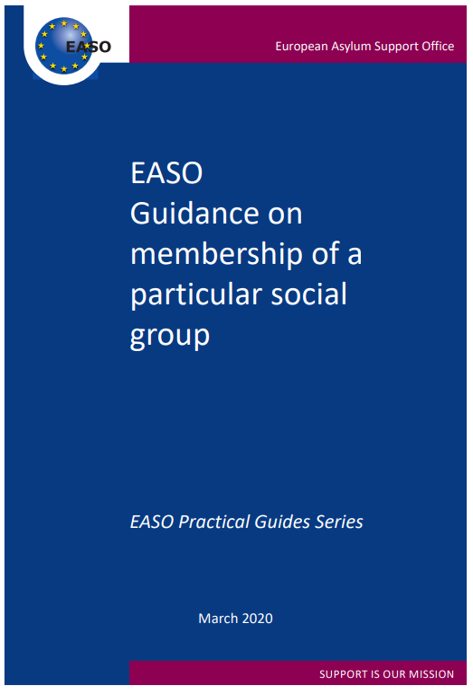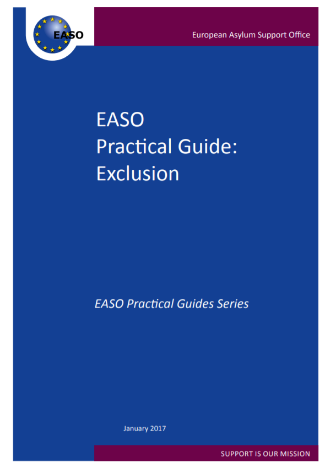The country guidance represents the common assessment of the situation in the country of origin by senior policy officials from EU Member States, in accordance with current EU legislation and jurisprudence of the Court of Justice of the European Union (CJEU).
This guidance note does not release Member States from the obligation to individually, objectively and impartially examine each application for international protection. Each decision should be taken on the basis of the individual circumstances of the applicant and the situation in Iraq at the moment of the decision, according to precise and up-to-date country information, obtained from various relevant sources (Article 10 of the Asylum Procedures Directive).
The analysis and guidance provided within this document are not exhaustive.
Below, you can learn more about the country guidance methodology and how this document was developed:
Why is this country guidance developed?
On 21 April 2016, the Council of the European Union agreed on the creation of a senior-level policy network, involving all Member States and coordinated by EASO, with the task to carry out a joint assessment and interpretation of the situation in main countries of origin.[1] The network supports EU-level policy development based on common country of origin information (COI), by jointly interpreting such information in light of the relevant provisions of the asylum acquis and taking into account the content of the EASO training material and practical guides where appropriate. The development of common analysis and guidance notes was also included as a key area in the new mandate of the European Union Agency for Asylum proposed by the European Commission.1F1F[2]
The country guidance is intended as a tool for policy-makers and decision-makers in the context of the Common European Asylum System (CEAS). It aims to assist in the examination of applications for international protection by applicants from Iraq, and to foster convergence in decision practices across Member States.
[back]
What is the scope of this update?
The current version of the guidance updates and replaces the ‘Country Guidance: Iraq’ (June 2019).
This update mainly focuses on the chapters of subsidiary protection (Article 15(c) QD) and internal protection alternative, as well as on the following profiles: persons perceived to be associated with ISIL, political opposition activists and protesters, and religious and ethnic minorities and stateless persons. The chapter on exclusion has also been reviewed and updated.
Minor changes have also been introduced in other parts of the horizontal framework of the document and the analysis has been developed with regard to the profiles of women and children. These changes do not generally impact the assessment of the situation in Iraq as per the previous version of the guidance from June 2019.
[back]
Is this guidance binding?
The country guidance, developed by the Member States and published by EASO, is not binding. The guidance note, accompanied by the common analysis, shall be taken into account by Member States when examining applications for international protection, without prejudice to their competence for deciding on individual applications.
[back]
Who was involved in the development of this country guidance?
This document is the result of the joint assessment by the Country Guidance Network, whose work was supported by a Drafting Team of selected national experts and by EASO. The European Commission and UNHCR provided valuable input in this process.
[back]
What is the applicable legal framework?
In terms of applicable legal framework, the common analysis and guidance note are based on the provisions of the Qualification Directive (QD)[3] and the 1951 Geneva Convention Relating to the Status of Refugees, as well as jurisprudence of the Court of Justice of the European Union (CJEU); where appropriate, the jurisprudence of the European Court of Human Rights (ECtHR) is also taken into account..
[back]
What guidance on qualification for international protection is taken into account?
The horizontal guidance framework applied in this analysis is based primarily on the ‘EASO Practical Guide: Qualification for international protection’ and the ‘EASO Practical Guide: Exclusion’.[4] It also takes into account relevant Judicial Analyses, published by EASO, and in particular those on ‘Qualification for International Protection (Directive 2011/95/EU)’, ‘Article 15(c) Qualification Directive (2011/95/EU)’, and on ‘Exclusion: Articles 12 and 17 Qualification Directive (2011/95/EU)’.[5]
Relevant UNHCR guidelines, and in particular ‘International Protection Considerations with Regard to People Fleeing the Republic of Iraq’, are also taken into account.[6] [7]
[back]
What country of origin information has been used?
The EASO Country Guidance documents should not be considered and should not be used or referenced as sources of country of origin information (COI). The information contained herein is based on EASO COI reports[8] and, in some instances, other sources, as indicated. Unlike the Country Guidance, these represent COI sources and can be referenced accordingly.
The country information analysed hereby includes, in particular, the following EASO COI reports/queries:
|
■
|
COI Report: Security situation (October 2020) [EN]
|
|
■
|
COI Query: Security context and treatment of Christians (October 2020) [EN]
|
|
■
|
COI Report: Treatment of Iraqis with perceived affiliation to ISIL (October 2020) [EN]
|
|
■
|
COI Report: The protest movement and the treatment of protesters and activists (October 2020) [EN]
|
|
■
|
COI Query: Treatment of Sabean-Mandean minority in Iraq (October 2020) [EN]
|
| ■ | COI Query: Ethno-religious minorities and stateless persons (September 2020) [EN] |
|
■
|
COI Query: Security context and treatment of Yazidis in Iraq (September 2020) [EN]
|
|
■
|
COI Report: Key socio-economic indicators, for Baghdad, Basrah and Erbil (September 2020) [EN]
|
|
■
|
COI Report: Iraq Security situation (March 2019) [EN]
|
|
■
|
COI Report: Iraq Targeting of individuals (March 2019) [EN]
|
|
■
|
COI Report: Iraq Key socio-economic indicators (February 2019) [EN]
|
|
■
|
COI Report: Iraq Internal Mobility (February 2019) [EN]
|
|
■
|
COI Report: Iraq Actors of protection (November 2018) [EN]
|
References within this document are to the respective sections of these COI reports.
In addition, a UNHCR report on access and residency requirements in Iraq, issued in November 2019 has been used as a complementary source on the topic. [9]
See Annex II. Country of origin information references.
[back]
How does country guidance assist in the individual assessment of applications for international protection?
The guidance note and common analysis follow the steps of the examination of an individual application for international protection. This document looks into the relevant elements according the QD and provides a general assessment of the situation in the country of origin, along with guidance on relevant individual circumstances that should be taken into account.
Its approach is consistent with, and should be read in conjunction with, the more detailed horizontal guidance. For an outline and additional guidance on qualification for international protection and exclusion, see:
 |
|||
|
EASO Practical Guide:
Qualification for international
protection[10]
|
EASO Practical Guide:
Qualification for international protection[11]
|
EASO Guidance on
membership of a particular
social group[12]
|
EASO Practical Guide: Exclusion[13]
|
[back]
How is this document structured?
The country guidance is structured into guidance note and common analysis:
 |
| Figure 1. Country guidance elements. |
[1] Council of the European Union, Outcome of the 3461st Council meeting, 21 April 2016, 8065/16, available at http://www.consilium.europa.eu/media/22682/st08065en16.pdf. [back to text]
[2] European Commission, Proposal for a Regulation of the European Parliament and of the Council on the European Union Agency for Asylum and repealing Regulation (EU) No 439/2010, 4 May 2016, 2016/0131 (COD), available at https://ec.europa.eu/home-affairs/sites/homeaffairs/files/what-we-do/policies/european-agenda-migration/proposal-implementation-package/docs/20160504/easo_proposal_en.pdf. [back to text]
[3] Directive 2011/95/EU of the European Parliament and of the Council of 13 December 2011 on standards for the qualification of third-country nationals or stateless persons as beneficiaries of international protection, for a uniform status for refugees or for persons eligible for subsidiary protection, and for the content of the protection granted. [back to text]
[4] EASO Practical Guides are available at /practical-tools. [back to text]
[5] Judicial analyses published by EASO are available at /courts-and-tribunals. [back to text]
[6] UNHCR Handbook and guidelines on procedures and criteria for determining refugee status under the 1951 Convention and the 1967 Protocol Relating to the Status of Refugees, as well as other guidance, policy documents and UNHCR ExCom and Standing Committee conclusions are available at https://www.refworld.org/rsd.html. [back to text]
[7] UNHCR, International Protection Considerations with Regard to People Fleeing the Republic of Iraq, May 2019, available at https://www.refworld.org/docid/5cc9b20c4.html. [back to text]
[8] EASO COI reports are available at /information-analysis/country-origin-information/country-reports. [back to text]
[9] UNHCR, Iraq: Country of Origin Information on Access and Residency Requirements in Iraq: Ability of Persons Originating from Formerly ISIS-Held or Conflict-Affected Areas to Legally Access and Remain in Proposed Areas of Relocation (Update I), 6 November 2019, available at https://www.ecoi.net/en/file/local/2019573/5dc04ef74.pdf. [back to text]
[10] ‘EASO Practical Guide: Qualification for international protection’, Flowchart for practitioners, available at /sites/default/files/easo-flowchart-for-practicioners-qualification-for-international-protection-2018.pdf [back to text]
[11] ‘EASO Practical Guide: Qualification for international protection’, available at /sites/default/files/easo-practical-guide-qualification-for-international-protection-2018.pdf [back to text]
[12] EASO Guidance on membership of a particular social group’, available at /sites/default/files/EASO-Guidance-on%20MPSG-EN.pdf [back to text]
[13] ‘EASO Practical Guide: Exclusion’, available at /sites/default/files/EASO%20Practical%20Guide%20-%20Exclusion%20%28final%20for%20web%29.pdf [back to text]

